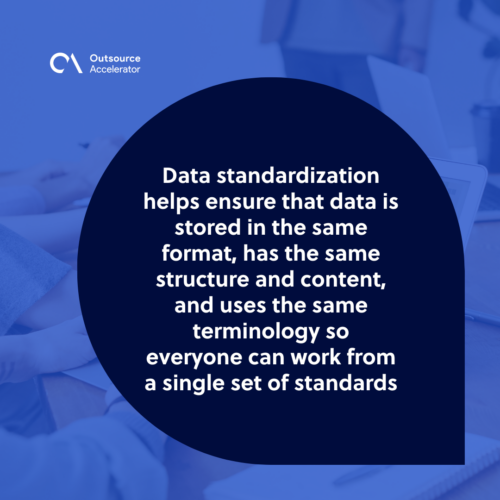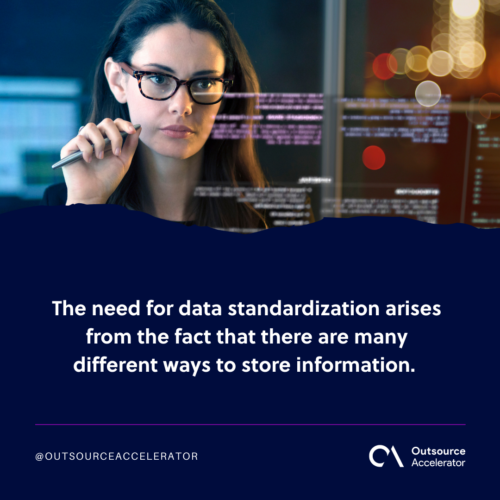A guide to data standardization for accuracy and consistency

In today’s data-driven era, organizations are grappling with vast amounts of information from various sources and systems. This surge in information demands the need to standardize data elements to ensure accuracy, consistency, and usability.
Enter data standardization, the process that brings harmony to the chaotic data landscape. With data standardization, order, consistency, and accuracy reign supreme.
Whether you’re a business owner, data analyst, or IT professional, join us as we delve into the world of data standardization. Discover how it can transform how you handle and leverage your valuable data.
What is data standardization?
Data standardization is the process of improving data quality by making it consistent across multiple dimensions. Standardizing data helps ensure that data is stored in the same format, has the same structure and content, and uses the same terminology so everyone can work from a single set of standards.
Data standardization is often seen as a precursor to data integration. Once standardized, data can be combined into a single store for analysis.
Data standardization is also an important step towards making input data more useful for analytics purposes. When different systems use different naming conventions or encoding schemes for the same concepts, it’s impossible to use them together effectively.
The goal of data standardization is to ensure that each unique piece of information in your dataset has only one representation.
This means that if you have multiple records for something like a person’s name, then the duplicates should be removed so that each person only appears once.
If you also have the same pieces of information (like addresses or phone numbers), then they should be consolidated into one record.
By adhering to these practices, companies can streamline their data processing activities and improve overall data quality.

Data standardization vs. Data normalization
Data normalization and data standardization are two terms often used interchangeably by people in the data management industry.
They are both methods of ensuring that the same data is stored in similar formats across multiple databases. But they do differ in their approach to the problem.
Data normalization is a process of removing redundant information from your data set so that it’s easier to update and maintain. It’s also a core component of relational database design and is used to ensure that your database tables are consistent, efficient, and accurate.
Data standardization, meanwhile, refers to the process of ensuring that values in one or more columns of a table are consistent with other values in the same column. In practice, this often means that all data fields are converted from free text into numerical values.
While both processes can be used to achieve the same goal — namely, ensuring that data is consistent, reliable, and accurate — they are not interchangeable.
Data normalization focuses on structuring data in a way that makes it easier for users to understand and manipulate it. Meanwhile, data standardization focuses on providing a set of rules for how data should be structured.
4 types of data standardization errors
Unstandardized data is full of errors, many of which occur due to faulty data entry. These are some of the forms that unstructured data can take in your system:
Data type inconsistency
Data type inconsistency errors occur when different data types are mixed in a single field. It’s the most common data standardization error and happens when data is not classified properly into the correct categories.
Data types define how much space a field can hold, as well as determine how data is stored within your database. A data type error can cause significant problems in your database.
Structural inconsistency
When there is a mismatch between the structure of the source data and target data, it is known as structural inconsistency. This refers to a difference in the number of fields or orders between two datasets.
Structural inconsistencies are a type of data standardization error that occur when records have different fields but the same values.
This problem can be fixed by creating one new field that combines those different fields together. The result is that all values in both records are now merged together in a single place.
Format inconsistency
Formatting inconsistencies are the most common and obvious form of data standardization errors.
These errors occur when the format of your data does not match the format expected by your application or model.
Domain value inconsistency
Domain value inconsistency refers to when data is stored in different formats or when one field is used for multiple purposes. This can lead to confusion and errors as users try to reconcile their understanding of the data with what they see on screen.
The solution to domain value inconsistency is to avoid duplicate records and use a single source of reference instead.
Data standardization process
Here is a general outline of the data standardization process:
Business rules
Before data standardization occurs, business rules must be applied to source data to prepare it for integration. Three main categories of business rules are used:
- Taxonomy rules – These rules help enforce a hierarchy of data by removing invalid entries that are outside the data value range.
- Reshape rules – These reconfigure incoming data into useful structures within the system. For example, if a source decides to send a compilation of its data instead of separate tables, these rules will reconfigure the table into a form that’s more suitable.
- Semantic rules – These rules peer into the data itself to describe its domain. This is essential because each business brings a unique operational context.

Assess and declutter data sources
Work with stakeholders to determine which data needs to be standardized. You’ll need to prepare an audit that covers:
- Internal and external data sources
- Data generation frequency from each data source
- All teams that manage and access that data source
- Changes made to the data
Afterward, you’ll create a list of formal criteria which will guide you on decluttering data. Clean data is easier to standardize.
Assess data collection methods
Within data standardization, it’s critical to understand how low-quality data enters your database. Data collection methods can be fixed or modified to reduce the frequency of low-quality data in your system.
When assessing data collection methods, consider the following:
- Internal and external data entry forms
- Third-party data imports
- Integrations
Define data standards
This is a crucial step in the data standardization process, as you’ll define what standard meets your organizational needs.
Designing a data model for your organization is an excellent way to define a standard. Your data model will represent an ideal state to which succeeding data values should conform.
A designed data model can then visualize the defined standard for every data asset and how they relate to each other.
Test for standard
This step is where actual data standardization techniques come into play:
- Parsing records and attributes – Before a dataset can be screened for errors, it must be parsed to identify components that need to be tested for standardization.
- Building data profile report – Next, you’ll use a data profiling tool to create reports on different statistics about data attributes.
- Matching and validating patterns – Any data that doesn’t follow a given pattern gets flagged during testing.
- Using dictionaries – You can run values against dictionaries or knowledge bases to test certain data fields for standardization.
- Testing addresses for standardization – When testing for data standardization, sometimes you’ll need to test specialized fields like locations or addresses. Address standardization checks the format of addresses and converts accordingly.
Transform
Finally, you’ll convert the non-conforming values into a standardized format. This includes the following processes:
- Transforming field data types
- Transforming patterns and formats
- Transforming measurement units
- Expanding abbreviated values
- Removing noise
- Reconstructing values
These processes can be done using automated tools.
Data integration
The standardized data is integrated into the target system or database. This may involve data migration, where data is transferred from legacy systems to new platforms.
During this process, data integrity and consistency are maintained, ensuring that the standardized data fits seamlessly into the target environment.
Documentation and maintenance
Document the data standards, mappings, and transformation rules for future reference. Documentation serves as a guide for data management and maintenance, enabling you to enforce data standardization rules across the organization.
Establish data governance policies and procedures to maintain standardized data over time. This includes monitoring data quality, enforcing compliance with data standards, and addressing any new challenges or changes in the data landscape.
Why is data standardization important?
The need for data standardization arises from the fact that there are many different ways to store information.
One company may use a text file to store customer information, while another might use an encrypted binary file. A third firm might use a relational database management system (RDBMS) to store customer records.
All these methods are valid, but they are not compatible with each other and cannot be combined directly into one repository.
Standardizing data means taking information from various sources and converting them into a common format so they can be aggregated together into a single repository.

Here are some other major benefits of data standardization:
Reduced costs
Data standardization cuts down on IT costs by reducing the number of applications needed to run an organization’s business. By implementing a single platform for all your data management, you can significantly reduce your reliance on multiple silos of data.
Improved efficiency
It improves efficiency and productivity by ensuring data is easy to find, understand, manage, and use. Data standardization also helps reduce redundancy and enables data sharing between different departments or divisions within an organization.
Easier processes
Data standardization helps make it easier to search for specific information within a database or other storage device. This allows users to find the information they need more quickly without having to sift through the unorganized data quantity in search of what they’re looking for.
It’s also easier for users to create reports from large quantities of data without spending time cleaning up the information before creating their report.
Better decision-making
Data standardization will allow you to make better decisions about how best to leverage it. This covers improvements in efficiency, service quality, operational capability, customer experience, and financial performance.
A unified approach allows businesses to derive meaningful insights from every data point they collect.







 Independent
Independent




